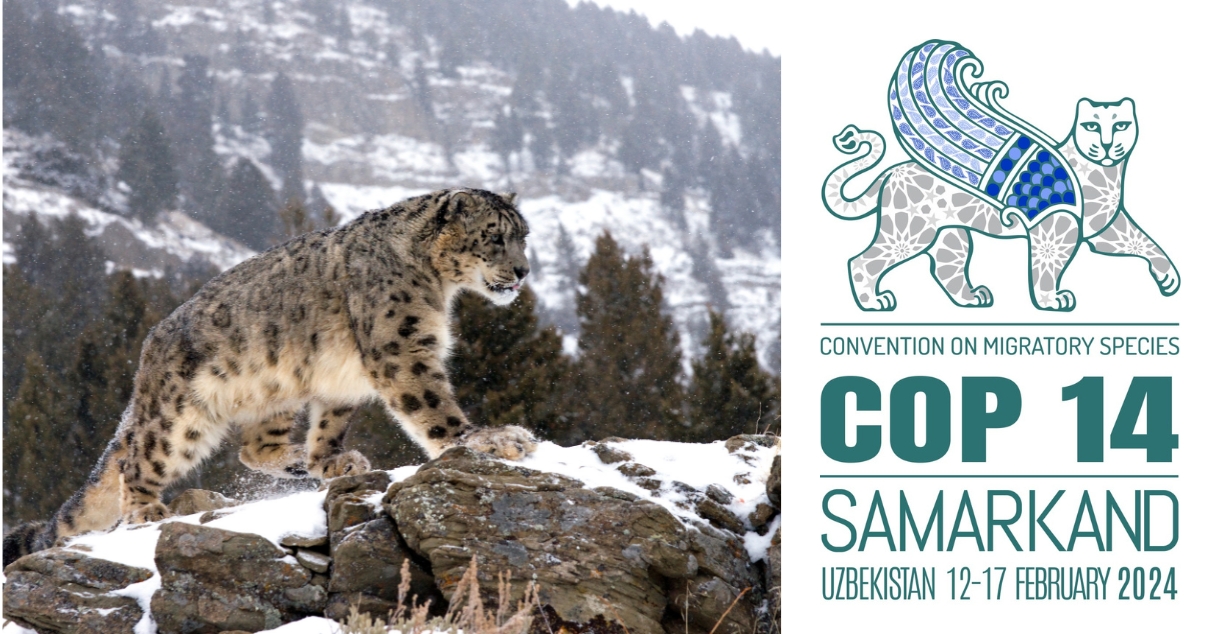Official Logo and Slogan Announced for the 14th Meeting of the Conference of the Parties to the Convention on Migratory Species

The snow leopard is a keystone species in Uzbekistan and was therefore chosen as main symbol of the COP14 logo.
Bonn / Samarkand, 14 August 2023 – In the lead-up to the forthcoming 14th Meeting of the Conference of the Parties to the Convention on the Conservation of Migratory Species of Wild Animals (CMS COP14), the Government of Uzbekistan and the CMS Secretariat are pleased to unveil the conference's official logo and slogan. The UN wildlife conservation conference is set to take place in the historic city of Samarkand, Uzbekistan, from 12 to 17 February 2024.
The logo for the conference features a winged snow leopard adorned with a pattern that brings to mind the famous lapis lazuli tiles of Central Asian monuments. The snow leopard is a keystone species in Uzbekistan, with a range that extends across 12 countries. The powerful and elusive big cat is also the legendary symbol of Samarkand, which is widely found throughout the country, from the magnificent entrance of the historic Sher Dor Madrasah school to Uzbekistan’s national bank notes.
While the snow leopard is a sacred symbol of power and benevolence, its conservation status is of great concern, with only 2,700 to 3,300 individuals thought to exist in the wild (Source: IUCN Red List of Threatened Species).
The conference will be convened under the slogan, "Nature knows no borders", which, along with the logo, is a reminder that the journeys of migratory species do not adhere to political boundaries, and that their survival is dependent on international collaboration and transboundary conservations efforts.
The slogan reflects the core of the CMS mandate and builds on the historic resolution of the UN General Assembly in 2021: "Nature knows no borders: transboundary cooperation – a key factor for biodiversity conservation, restoration and sustainable use" (A/75/L.73). The proposal, led by countries from Central Asia, urged all UN Member States to increase international and transboundary cooperation to maintain and enhance the ecological connectivity of transboundary habitats, cross-border protected areas, and ecosystems that are either vulnerable or form part of the migratory range of specific species.
With the unveiling of the logo and slogan, the stage is set for CMS COP14, a significant international meeting where governments, scientists and stakeholders will come together to agree on strategies for the conservation of migratory species and their habitats.
CMS COP14 will be the first global biodiversity gathering since the adoption of the Kunming-Montreal Global Biodiversity Framework (GBF) in 2022, and will address a wide range of important conservation priorities and new initiatives, including many that will support the implementation of the GBF. The triennial international meeting will highlight the issues of habitat conservation and restoration as well as threats to species such as overexploitation, habitat loss and fragmentation, pollution and climate change. It will also provide a unique opportunity for the launch of major new reports and guidelines, including the first-ever report on the ‘State of the World’s Migratory Species’, new global guidelines on light pollution, and best practices for linear infrastructure to minimize impacts on migratory species.
COP14-associated events and meetings such as the 54th Meeting of the CMS Standing Committee, the High-Level Segment and the Migratory Species Champion Night will take place in the same location on 11 February.
As delegates gear up for the conference, the winged snow leopard and the slogan, "Nature knows no border", are potent reminders of our shared commitment to preserving our planet's migratory species.
Visit the CMS COP14 information hub to find out more about the conference.
| Official translations of the COP14 slogan: Nature knows no borders | |
| French | La nature ne connaît pas de frontières |
| Spanish | La naturaleza no conoce fronteras |
| Russian | Природа не знает границ |
Last updated on 14 August 2023


